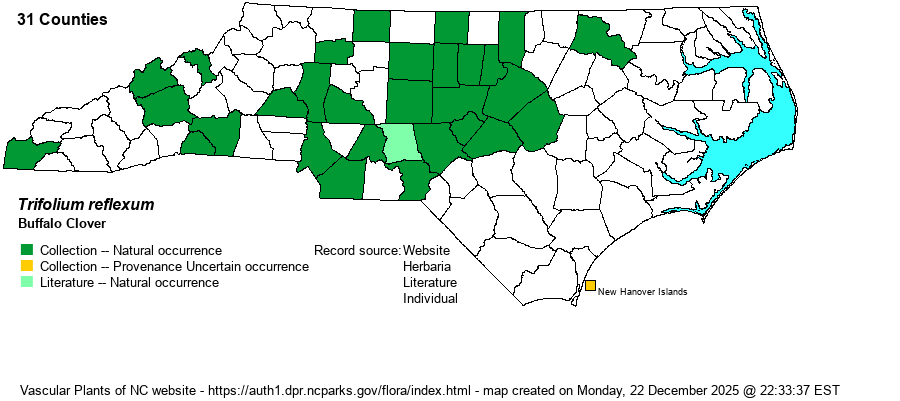| Author | L. | |
| Distribution | Occurs (or occurred) over nearly all of the Piedmont, but strongly declining and thus no recent records for most of them. Scattered in the central and southern Mountains, and a record or two from a coastal island from the southern coast (New Hanover County), though this last might be not natural.
The species has a wide Eastern range, from NY to IA, and south to FL and TX, but is mostly absent from the Coastal Plain. It has greatly declined across this range in recent decades, however. | |
| Abundance | Strongly declining in recent decades. Formerly, about 50 years ago, it was generally uncommon in the Piedmont, but now it is rare (to locally uncommon) across the province, most frequent in the eastern third of the province, and very rare in the western Piedmont and mountains. Casual in the Coastal Plain, and probably now extirpated there. This species seldom occurs in sizable stands, and it seems to get shaded out by taller species or populations often "blink out" for uncertain reasons, despite suitable habitat still being present. Owing to the strong decline in the state, it is given a State Threatened status. Despite it being known from at least 29 counties, the S1S2 State Rank seems appropriate, as nearly all recent populations are very small. | |
| Habitat | This is a species of dry to mesic places on mainly circumneutral soil, of glades and barrens, woodland borders, and open woodlands -- usually in partial shade. Locations are most often located over rocks such as gabbro, diabase, amphibolite, and a few others. | |
| Phenology | Blooms mainly in May into June, and fruits shortly after flowering. | |
| Identification | This native species looks quite similar to the exotic Red Clover (Trifolium pratense) or Alsike Clover (T. hybridum) at first glance, and if flowers are not visible, most biologists would overlook it or simply call it as one of the many exotic species of clovers. This species often has several stems (actually branches near the base), erect to ascending, and reaching about 10-12 inches tall. The plant is rather hairy overall, not really a defining character. The scattered leaves have long petioles, often 2 inches long, and the 3 leaflets are elliptical with rounded tips, about 1 inch long, similar to other large clovers. The leaflets have finely serrated margins. The key feature is that the flowering head is raised well above the leaves, unlike with the abundant Red Clover (where the head looks like it is resting on leaflets), and this stalk is generally around 1-1.5 inches high. The flower head is about 1 inch across or more, with the standard being red and the keel and wing petals being white, yielding a reddish to pink color to the head. During flowering and especially afterwards, the lower half of the flowers in the head droop or hang downward, giving an odd two-parted flower cluster, or an erect top half and a drooping bottom half -- hence the specific epithet name of "reflexum". Alsike Clover is quite similar, but has a noticeably longer flowering stalk -- about 2-3 inches long and a smaller head, about 3/4-inch across. Also, its flower head is white to rose in color, but not deep red or carmine, nor does the bottom half of the flower cluster droop as in Buffalo Clover. There are differences in the calyx lobes as well, but Alsike Clover -- reasonably common as a weed -- essentially grows in open fields or other obviously disturbed wasteland and clearings -- generally in full sun. Though Buffalo Clover does not grow in large patches of hundreds of plants, thankfully a dozen or two dozen plants may grow in a dense patch along a wooded margin or glade-like opening in dry woods. If only one or two individual plants were to grow at a site, the species would certainly be overlooked, at least when not in bloom. The reasons for the strong decline rangewide are not obvious, and this decline is simply more than just to development. It may be that it is one of the relatively few "Piedmont" plants that has a strong affinity for fire, and of course fires are strongly suppressed in the province, except in some nature preserves that use prescribed fires to cut back on woody plants to favor growth of herbaceous species. The common name of Buffalo Clover might suggest that in parts of its range it grew in prairies and other openings where American Bisons used to roam. | |
| Taxonomic Comments | None
Trifolium is a large genus of some 240-250 species globally, mostly north-temperate zone. Most are readily recognized as a clover by their 3 broad leaflets and globular to hemispherical head of densely-packed flowers. Flowers vary from white to pink, and red; the hop clovers have tiny yellow flowers. Some species were introduced for their forage value for livestock, others hitched a ride with hay, packing material, etc. Our two native species -- T. carolinianum and T. reflexum -- have suffered great loss of habitat and are now rare. | |
| Other Common Name(s) | None | |
| State Rank | S1S2 | |
| Global Rank | G3G4 | |
| State Status | T | |
| US Status | | |
| USACE-agcp | | |
| USACE-emp | | |

